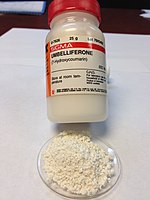Loading AI tools
Chemical compound From Wikipedia, the free encyclopedia
Umbelliferone, also known as 7-hydroxycoumarin, hydrangine, skimmetine, and beta-umbelliferone, is a natural product of the coumarin family.
This article needs additional citations for verification. (March 2020) |
 | |
 | |
| Names | |
|---|---|
| Preferred IUPAC name
7-Hydroxy-2H-1-benzopyran-2-one | |
| Other names
7-hydroxycoumarin, hydrangine, skimmetine, beta-umbelliferone | |
| Identifiers | |
3D model (JSmol) |
|
| ChEBI | |
| ChEMBL | |
| ChemSpider | |
| ECHA InfoCard | 100.002.038 |
PubChem CID |
|
| UNII | |
CompTox Dashboard (EPA) |
|
| |
| |
| Properties | |
| C9H6O3 | |
| Molar mass | 162.14 g/mol |
| Appearance | yellowish-white crystalline odorless powder |
| Melting point | 230 °C (446 °F; 503 K) (decomposes) |
| -88.22·10−6 cm3/mol | |
Except where otherwise noted, data are given for materials in their standard state (at 25 °C [77 °F], 100 kPa).
| |
It absorbs ultraviolet light strongly at several wavelengths. There are some indications that this chemical is antimutagenic,[1] it is used in sunscreens.[2] Umbelliferone has been reported to have antioxidant properties.[3][4]
It is a yellowish-white crystalline solid that has a slight solubility in hot water, but high solubility in ethanol.
Umbelliferone's name is from the umbelliferae family of plants, and the plant family in turn was named for their umbrella-shaped inflorescences, each called an umbel.
Umbelliferone occurs in many familiar plants from the Apiaceae (Umbelliferae) family such as carrot, coriander and garden angelica, as well as in plants from other families, such as the mouse-ear hawkweed (Hieracium pilosella, Asteraceae) or the bigleaf hydrangea (Hydrangea macrophylla, Hydrangeaceae, under the name hydrangine).
It is one of the components of asafoetida, the dried latex from the giant fennel (Ferula communis).
It is also found in Justicia pectoralis (Acanthaceae).[5][6]
Umbelliferone is a phenylpropanoid and as such is synthesized from L-phenylalanine, which in turn is produced via the shikimate pathway. Phenylalanine is lyased into cinnamic acid, followed by hydroxylation by cinnamate 4-hydroxylase to yield 4-coumaric acid. The 4-coumaric acid is again hydroxylated by cinnamate/coumarate 2-hydroxylase to yield 2,4-dihydroxy-cinnamic acid (umbellic acid) followed by a bond rotation of the unsaturated bond adjacent to the carboxylic acid group. Finally an intramolecular attack from the hydroxyl group of C2' to the carboxylic acid group closes the ring and forms the lactone umbelliferone.
Umbelliferone is traditionally synthesized using the Pechmann condensation, from resorcinol and formylacetic acid (generated from malic acid in situ).[7]
A newer synthesis uses methyl propionate and a palladium catalyst.
Umbelliferone absorbs strongly at 300, 305 and 325 nm, with log ε values of 3.9, 3.95 and 4.15 respectively, and it fluoresces blue in both ultraviolet and visible light. The powerful absorption at three different wavelengths, coupled with the fact that the energy is dissipated safely as visible light, make umbelliferone a useful sunscreen agent. The absorption changes in alkaline solution, since the phenolic hydroxyl group is deprotonated (pKa = 7.7).
The ultraviolet activity of umbelliferone led to its use as a sunscreen agent, and an optical brightener for textiles. It has also been used as a gain medium for dye lasers. Umbelliferone can be used as a fluorescence indicator for metal ions such as copper and calcium. It acts as a pH indicator in the range 6.5-8.9.[citation needed]
Umbelliferone is a potent inhibitor of type 3 17β-hydroxysteroid dehydrogenase, the primary enzyme responsible for the conversion of 4-androstene-3,17-dione to testosterone, with IC50 of 1.4 μM.[8]
Umbelliferone is the parent compound for a large number of natural products. Herniarin (7-O-methylumbelliferone or 7-methoxycoumarin) occurs in the leaves of water hemp (Eupatorium ayapana) and rupturewort (Herniaria). O-Glycosylated derivatives such as skimmin (7-O-β-D-glucopyranosylumbelliferone) occur naturally and are used for the fluorimetric determination of glycoside hydrolase enzymes. Isoprenylated derivatives are also widespread, such as marmin (found in grapefruit skin and in the bark of the Bael tree) and furocoumarins such as marmesin, angelicin, and psoralen.
Umbelliferone 7-apiosylglucoside can be isolated from the root of Gmelina arborea.[9]
Seamless Wikipedia browsing. On steroids.
Every time you click a link to Wikipedia, Wiktionary or Wikiquote in your browser's search results, it will show the modern Wikiwand interface.
Wikiwand extension is a five stars, simple, with minimum permission required to keep your browsing private, safe and transparent.